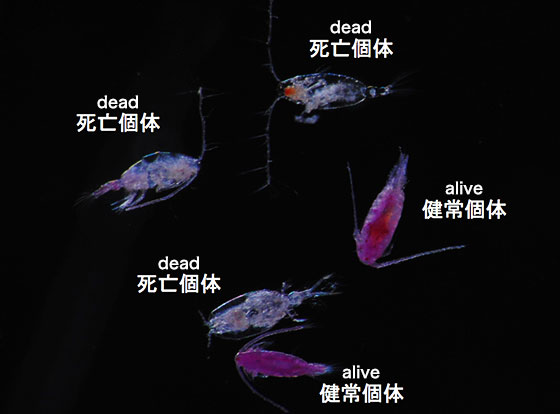News
Possible Mass-Death of Zooplanktons in Japanese Coastal Areas if Seawater Temperature Rises above 21 Degrees Celsius Updated in May 2019
Nutrients for sea creatures are made by phytoplanktons. Planktons are creatures that do not swim by themselves, but move about according to the flow or current of seawater. Just like plants on earth, various small phytoplanktons drifting near the ocean surface produce nutrients from carbon dioxide and water through photosynthesis of the sun. Zooplanktons eat these nutritious phytoplanktons. Then the zooplanktons are eaten by small fish. Then a large fish will eat the small fish. The nutrients created by phytoplanktons sustain all the organisms in the food chain.
This food chain is of utmost importance. If this chain is broken, the original ecosystem will be damaged. Rapid global warming has raised the temperature of seawater and the chain may start to fall apart in different ways. A group of researchers headed by Prof. Kam W. Tang (Swansea University) and Prof. Kazutaka Takahashi (University of Tokyo) confirmed that zooplanktons in the western coast of Japan may be prone to death if seawater temperature exceeds 21 degrees Celsius. Zooplanktons are fundamental nutrients supporting sea creatures, so this change may have a major impact on the ecosystems related to all organisms.
For this research, the group developed a special staining method whereby live organisms would turn red and dead ones would stay colorless. By collecting zooplanktons from Seto Inland Sea (near Shikoku region), Hamanako Lake (Shizuoka Prefecture), Sagami Bay (Kanagawa Prefecture), Tokyo Bay, and Otsuchiwan Bay (Iwate Prefecture), during May-June of 2013, an average of 4.4%-18.1% and up to 53% of commonly observed zooplanktons called copepod genera were already dead in seawater. Moreover, they found that deaths for Acartia Dana, commonly found in seawater around the world, increased rapidly when the average seawater temperature (from the surface to the bottom of the sea) rose above 21 degrees Celsius.
According to Prof. Takahashi, there have been studies monitoring changes in zooplankton distribution in relation to the rise in seawater temperature. Near the shores of Japan, there were studies that looked into how planktons in the south would spread out north, for instance. But there aren’t many studies that focus on the survival rate of zooplanktons in relation to seawater temperature.
The study also found that almost half of the zooplankton carcasses submerged and sedimented on the bottom of the seabed. If the dead planktons are decomposed by bacteria, they can turn into sources of nutrients again, but if they become sediments, they will be excluded from the nutrition cycle. It is believed that the nutrients produced by phytoplanktons are efficiently passed on to zooplanktons, to small fish, and then to larger fish. With the rise in seawater temperature however, the cycle could become vulnerable at the point where zooplanktons come in. This may deprive fish from taking in enough nutrients, points out Takahashi.
Japan's sea temperature is rising faster than the world's average. Even in northern areas like Otsuchiwan Bay, average summer seawater temperature could reach 21 degrees Celsius now. The ecosystem is complex. Organisms can adapt to environmental changes, but it is difficult to exactly predict what will happen when seawater should exceed 21 degrees from global warming. However, the study shows that something drastic could happen in the near future.
ICES Journal of Marine Science
https://academic.oup.com/icesjms/article-abstract/76/6/1825/5368121?redirectedFrom=fulltext








